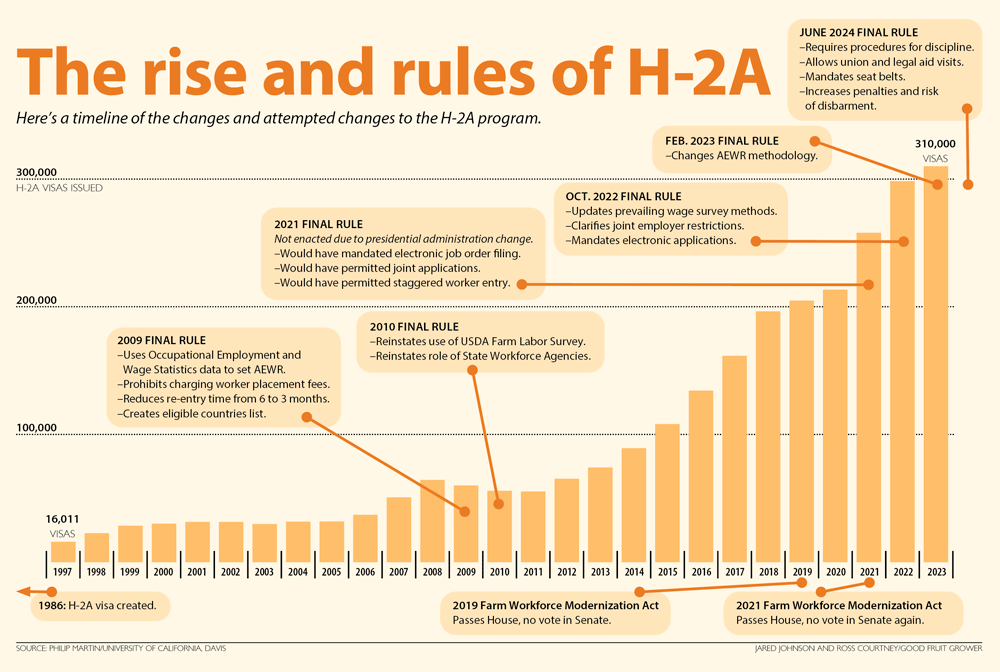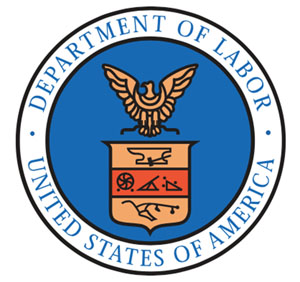—story by Ross Courtney
—graphic by Jared Johnson

For the third time in four years, agricultural employers are adjusting their operations for a new round of H-2A regulatory changes.
“The issue is keeping up with it,” said Sean Gilbert, president of Gilbert Orchards near Yakima, Washington.
Finalized in late April, the latest changes from the U.S. Department of Labor cover disciplining employees, union activity, wage documentation and more. The final rule, which took effect June 28, calls for more stringent enforcement, including lowering the bar for errors that can result in banning employers from using the H-2A program.
Regulations now require seat belts on all employer-owned vans hauling crews to and from work sites. Many states, including Washington, already have seat belt laws, and Gilbert Orchards has long insisted employees use them. But Gilbert now wonders if it’s up to his company to enforce and prove it.
His vans have video cameras, he said, “but we don’t have them on everybody’s laps.”
The issue is likely to garner more attention following two crashes in May, one in Florida and the other in Idaho, in which a combined 14 H-2A workers died. The Idaho crash remains under investigation. In the case of the Florida crash, the vehicle carrying the workers was not equipped with seat belts, according to a Florida Highway Patrol spokesman.
Beyond seatbelts, the latest regulatory updates delve into the nitty-gritty details of how farmers manage their employees in a way the federal government has not before, said Enrique Gastelum, CEO of wafla, the Lacey, Washington, nonprofit that facilitates most H-2A visa hires in the Northwest.
“They are removing at-will employment,” Gastelum said.
For example, terminating an H-2A employee now requires five factors: a warning about specific policy violation; an issue under the employee’s control; consistent enforcement among other workers; a “fair and objective” investigation; and progressive disciplinary steps leading up to the termination. The regulations also specify those progressive steps.
Gastelum does not object to the purpose behind the rules. “They’re best practices,” he said.
The problem, he said, is that they are cumbersome to enact. It would be easy for a low-level supervisor to trip over one of the details.
Gastelum urges all farms to write clear employment policies and increase efforts to train supervisors at all levels. Get help from an attorney or organization, if necessary, he said.
Mike Gempler, executive director of the Washington Growers League, a Yakima nonprofit that helps facilitate H-2A hires, agreed that the pace of change has been fast lately.
“It’s been breathtaking,” Gempler said. “There’s been so many changes it’s hard to keep up with it.”
However, the details of this 600-page rule change might not be as heavy a lift in Washington as in states with less stringent labor regulations of their own. Requirements to disclose recruiter agreements won’t add any cost; seat belts are already required in many states; and, for years, employer groups have suggested employers adopt policies that require documented progressive discipline for workers before termination.
But the new regulations come at one of the fruit industry’s worst economic cycles in 20 years, as apple growers across the county struggle with low returns and wine grape growers remove acreage. A deep cold snap in January left some peach, cherry and pear growers in Washington wondering if they will harvest a crop.
Through May this year, Washington ag employers were on pace to hire about 7 percent fewer H-2A workers than last year, the first time since 2011 that number has declined.
Unions
The regulations also affect how employers interact with unions. President Biden generally supports unions, promising to be “the most pro-union president” in American history. He has a bust of Cesar Chavez in the White House.
In a 2021 case about union recruiters visiting farmworker housing, the U.S. Supreme Court upheld an employer’s right to regulate visitors. Generally, a union organizer cannot set up shop on the picnic tables outside a cluster of housing units, and employers are allowed to say no to overnight guests.
This rule change protects a worker’s right to “invite” guests into housing but also allows would-be guests to knock on doors seeking such an invitation. The same rule would apply to someone from a nearby church.
“A worker cannot choose to accept (or reject) a visitor if the worker has no way of knowing that a potential visitor wishes to communicate with them,” the Department of Labor wrote in the final rule.
The rule also continues to allow employers to hold meetings regarding unions but allows workers to skip those meetings and protects them against retaliation if they do.
Fruit industry advocates do not simply blame President Biden, said Diane Kurrle, senior vice president of the U.S. Apple Association, based in Falls Church, Virginia. Some provisions of earlier rule changes were drafted during the Trump administration, and many Labor Department employees span presidential terms.
Dialogue in D.C.
There are signs of progress in the political conversation about ag employment, Kurrle said. More policymakers are hearing about fruit left unpicked and producers shutting down business, while more Democrats have publicly supported freezes on the Adverse Effect Wage Rate, or AEWR, the regionalized federal minimum wage for H-2A workers.
“I think it’s starting to resonate with a lot of offices,” Kurrle said.
In May, USApple teamed up with about 10 other specialty crop groups to speak directly with U.S. Department of Agriculture Secretary Tom Vilsack and acting U.S. Department of Labor Secretary Julie Su. Having the ear of two high-level administrators was rare, she said.
Among the group was Gilbert, who traveled with the Northwest Horticultural Council, where he serves as vice president of the board.
He focused his comments on the rising AEWR. Most of his colleagues around the table did, too, though they didn’t plan it that way.
“It was notable to me that almost everyone said the same thing, that the scale of the AEWR increases is just overwhelming,” he said.
The industry will continue to adjust, as it always does, to the complicated and costly rule changes, he said, but the extra costs also contribute to the worst economic scenarios the fruit industry has seen since the 1990s.
“If we don’t solve the economic equation … then we’re not going to have an industry,” he said. •







Leave A Comment